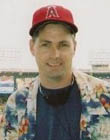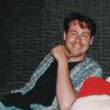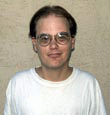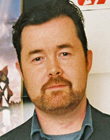|
|
This topic comprises 2 pages: 1 2
|
|
Author
|
Topic: 'As Good As It Gets' — New 70mm Demo Film
|
Michael Coate
Phenomenal Film Handler

Posts: 1904
From: Los Angeles, California
Registered: Feb 2001
|
 posted 04-28-2007 01:26 AM
posted 04-28-2007 01:26 AM




I mentioned in another discussion having recently attended a screening of a newly-shot 70mm demonstration film and that I would post more upon completion of an article. Here it is.
As I mention in the piece, the article (which is actually a Q&A with the demo's cinematographer) is no substitute for viewing the film, but can be useful as a source of insight into the making of the demo and serves as a point of discussion since many of us here on film-tech would love to see more high-quality imagery in everyday use.
FromScriptToDVD.com Interview
quote:
AS GOOD AS IT GETS
An Interview With Bill Bennett, ASC
By Michael Coate
If you spend a lot of time watching movies and television with a critical eye, you probably think you have a good idea of what a high-quality image looks like. Well, think again…because cinematographer Bill Bennett, ASC has just reset the bar!
Bennett, known affectionately by his peers as “The Car Guy” for his extensive résumé of TV commercials featuring slickly-photographed automobiles, recently shot a demonstration film which has been titled “As Good As It Gets.” The six-minute demo, captured in 65-millimeter(!), features breathtaking imagery of two young women trekking through the desert landscapes of Death Valley and the lush forests of the Sierra Nevada mountains. The film also features a drive through Los Angeles.
Originally shown at a film format seminar at UCLA in 2006, “As Good As It Gets” was privately screened on April 11 at the American Cinematheque’s Egyptian Theatre in Hollywood to a gathering of filmmakers, film-format enthusiasts and a journalist or two.
Among the attendees impressed by the demonstration was cinematographer M. David Mullen, ASC (“The Astronaut Farmer,” “Akeelah And The Bee”). “The simple truth is that Bill Bennett’s demo proves that oversampling works,” Mullen said. “It also makes you realize that we still have the technology to return cinema to the grandeur of 1960s epics like ‘Lawrence Of Arabia’ and ‘2001,’ when movies floored you with their technical quality on the big screen.”
“This looked TERRIFIC!!!,” remarked film historian Rick Mitchell, who also was in attendance. “The detail you could see was breathtaking. Little grain was visible, and I was sitting in the seventh row!”
So could this lead to a new feature shot in 65mm? “Maybe...if some contemporary filmmakers with TRUE VISION can be gotten to see this test film,” says Mitchell.
Following the screening, Bennett agreed to do an interview. The conversation, of course, is no substitute for actually viewing the film, but offers some insight into how and why the demo was made.
MICHAEL COATE, FROM SCRIPT TO DVD: How did you become involved with this project?
BILL BENNETT, ASC: I was having a meeting with Franz Krauz, CEO of Arnold & Richter, the parent company of Arriflex, at their offices in Munich, Germany, in the spring of '06. During that discussion, he asked me if I would shoot this demo.
FSTDVD: What is the objective of the demo?
BENNETT: During my discussion with Franz, we were talking about what we felt was a continuous decline over the past 30 years of the quality of images seen in the typical cinema, along with the fact that new digital camera and projector manufacturers were claiming that the images from their products were truly excellent.
Franz and I felt that we needed to shoot some material in the 65mm/5 perf format, using the latest modern film stocks, to “reset the bar” as far as high image quality is concerned. It has been many years since audiences have been able to view 70mm images that were shot in the ultra high resolution 65mm format.
We also wanted to have a source of high quality images to blend into 4k DI [Digital Intermediate] workflow streams, to prove the following: Assuming that you are doing a DI for your movie, and you are shooting in 35mm, you gain a lot more detail in your wide establishing shots if you shoot those shots in 65mm, scan them at 8k or 6k, downsample them to 4k, and blend them into your DI with your 35mm dialogue and close-up shots. We proved that at the November screening at UCLA, where we showed the same scene, shot in both 65mm and 35mm. In wide shots, the 65mm contained much more detail, when compared to the same scene shot in 35mm. In the close-ups, there was not as much of a noticeable difference, proving that you don’t need to shoot your entire movie in 65mm, just the wide shots, then blend them all together in your DI, to achieve a much better audience experience.
Recently, “The New World” (photographed by “Chivo” Emmanuel Lubezki, AMC, ASC), “We Fight To Be Free” (by Kees van Oostrum, ASC), and “The Prestige” (by Wally Pfister, ASC), all used 65mm for some of their wide shots, and incorporated it into their 35mm close-up photography.
Another objective of the project was to provide very high quality images in 8k for testing of digital projectors, DI workflow, compression algorithms, etc. To date, Sony, E-Film, Adobe, and Dolby Labs have been using the material for that purpose, and more are requesting access to the material.
FSTDVD: How were the locations selected?
BENNETT: I spent some time analyzing the wide shots in one of my favorite movies, “Lawrence Of Arabia,” which was shot in 65mm/5 perf. That movie was set in the desert where there was little atmospheric haze, allowing the camera to see for miles into the distance. I also noticed that director David Lean and cinematographer Freddie Young, BSC would often dolly side to side during their wide shots, while choosing locations and prop positions so that there were many layers to the shot leading off into the distance.
I followed that lead, shooting in the [California] high desert locations around Lone Pine, the Alabama Hills and Death Valley, as well as at 10,000 feet up in the Sierras. Like Lean and Freddie, I would dolly left to right during the shot, while choosing locations with many layers of depth, extending for miles off into the distance.
FSTDVD: How was this project funded?
BENNETT: Arriflex in Germany was the primary sponsor, paying for production costs, as well as providing all the cameras and lenses. Arri Film and Digital in Munich did the scanning and the first DI, seen in November of '06 at UCLA. Kodak was a significant sponsor in providing all the film stock. And FotoKem was also a significant sponsor, providing processing of all the negative, telecine for dailies, and scanning at 8k for the upcoming DI they are finishing in their facility.
E-Film and Deluxe Digital contributed by converting the DI done in Munich to the file projected on the Sony 4k projector at UCLA in November.
Many other companies contributed much to the production and finishing of the project. Sony provided the projector for the November screening. Server manufacturers provided the servers for that screening, etc.
FSTDVD: What cameras were used on the shoot?
BENNETT: The 65mm/5 perf camera was an Arriflex 765, using Zeiss Super PL mount lenses. The 35mm/4 perf camera was an Arriflex 435 Xtreme, using Zeiss UltraPrime spherical and Zeiss Arriscope Anamorphic lenses.
FSTDVD: What film stock(s) did you select?
BENNETT: We primarily utilized Kodak 5201, 50D, with some use of 5205, 250D, and one shot at night using 5218, 500T.
FSTDVD: At what frame rate was the film shot and projected?
BENNETT: Most of the demo was shot at 24 frames per second. The young woman on the rock with the cloth blowing overhead was shot at 60fps on all cameras. All the projection was at 24fps.
FSTDVD: What was the post-production workflow for this project?
BENNETT: First we processed the negative at FotoKem in Burbank, then we did a telecine of all the material there as well. I did an offline edit on my Macintosh using Final Cut Pro. We did an assembly of the HD telecine master from that offline, to use as a reference for the final DI. Then, that DI was done at Arri Digital Film in Munich where they scanned everything, both the 65mm and the 35mm material at 6k, then downsampled to 4k for the DI. They did a film out in two ways. First they created an internegative in the ArriLaser, which they printed to the 35mm release print stock. Then they did something never done before: they struck a 35mm release print directly in the ArriLaser, and projected that in the projector. It was startling to see how much resolution is lost in the contact printing of the internegative to the release print stock, as the “direct print” was very sharp.
The DI was projected using a 4k Sony projector, and the 35mm anamorphic prints were shown with a 35mm projector in the theatre.
The 70mm film print was contact printed directly from the camera original 65mm negative, and projected in 70mm in the theatre.
FotoKem is working on a new DI that contains more shots, where they are scanning the all the 65mm material at 8k, instead of the previous 6k, with the 35mm material scanned at 6k. We hope to show that DI around the time of Cine Gear.
FSTDVD: To whom has the demo been screened?
BENNETT: There was the first screening at UCLA in November of '06, where we showed the material in 4k digital projection, 35mm anamorphic film projection, and 70mm film projection. The next screening was in England a month ago at a wide screen convention held annually [at the National Media Museum in Bradford], where they showed the 35mm and the 70mm prints. The latest screening was the one you saw at the Egyptian Theatre in Hollywood. In each case, we invited people in the industry who were interested in seeing this sort of comparison. We plan to show it again just prior to the upcoming Cine Gear Expo [June 21-24].
FSTDVD: In what way would the film industry and moviegoers benefit from seeing films made in 65/70mm?
BENNETT: Vastly increased resolution and color depth on the screen. When we showed the 70mm print last November to the audience that had already seen the same shots in 4k digital projection and 35mm anamorphic film projection, they were blown away by the quality of the 70mm print. In fact, the audience asked to see the 70mm print a second time. I invited members of the audience who were sitting in the back to come sit on the floor in front of the first row to better see the image quality. Vilmos Zsigmond, ASC [“Close Encounters Of The Third Kind,” “The Deer Hunter,” “The Black Dahlia”] was sitting in the first row. After the screening, he came up to me and thanked me for shooting and showing the 70mm print, and he said that he had forgotten just how good it can look. That to me was the ultimate payoff for the whole thing, that someone as highly gifted as Mr. Zsigmond would recognize why we did it and totally appreciated it.
_____________
For more about Bill Bennett, ASC, see: www.wfb4.com
[ 05-08-2007, 06:50 PM: Message edited by: Michael Coate ]
| IP: Logged
|
|
|
|
|
|
|
|
|
|
|
|
|
|
|
|
|
|
|
|
|
|
|
|
|
|
|
|
|
|
|
|
All times are Central (GMT -6:00)
|
This topic comprises 2 pages: 1 2
|
Powered by Infopop Corporation
UBB.classicTM
6.3.1.2
The Film-Tech Forums are designed for various members related to the cinema industry to express their opinions, viewpoints and testimonials on various products, services and events based upon speculation, personal knowledge and factual information through use, therefore all views represented here allow no liability upon the publishers of this web site and the owners of said views assume no liability for any ill will resulting from these postings. The posts made here are for educational as well as entertainment purposes and as such anyone viewing this portion of the website must accept these views as statements of the author of that opinion
and agrees to release the authors from any and all liability.
|

 Home
Home
 Products
Products
 Store
Store
 Forum
Forum
 Warehouse
Warehouse
 Contact Us
Contact Us




 Printer-friendly view of this topic
Printer-friendly view of this topic










![[dlp]](graemlins/dlp.gif) .
.


![[Wink]](wink.gif)

![[Razz]](tongue.gif)


![[Smile]](smile.gif)
![[Confused]](confused.gif)




